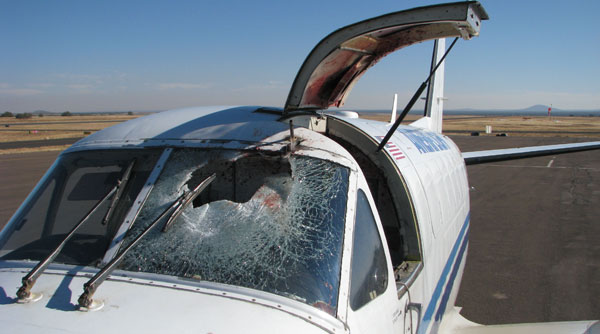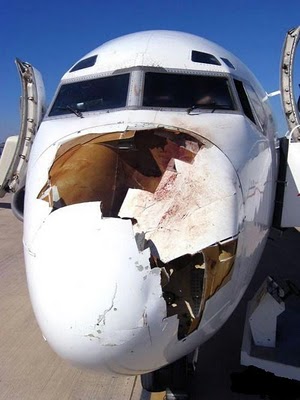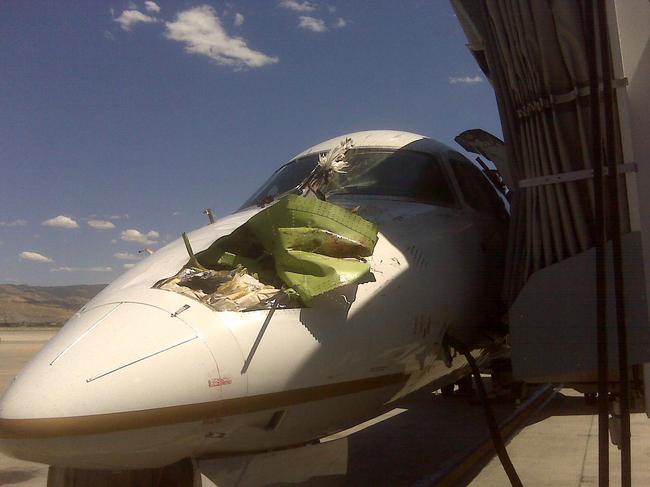
AIRSPACE REDESIGN INCREASES BIRD STRIKE HAZARD
FAA DOES NOT ADDRESS HAZARD
Bird strike is one of the leading causes of aviation disaster. In 2007 the US suffered 7,666 bird strikes. According to the FAA from 1990 to 2004, over 63,000 wildlife strikes were reported to the FAA. The airspace redesign sends an estimated 550 commercial planes a day directly over a Connecticut Audubon bird sanctuary on a redesigned north arrival path into La Guardia 22. Our organization asked the FAA how much the bird strike hazard would be increased by routing aircraft over a bird sanctuary and the FAA did not give an adequate response.
FAA HIDES BIRD STRIKE DATA FROM PUBLIC, CONGRESS, PRESS
Airspace Redesign Project Manager Steve Kelly confirmed through then Congressman John Hall’s office that the Airspace redesign’s “initial planning decisions did not take bird migration patterns into effect because they are everywhere.”
Kelly confirmed they did not produce a supplemental risk analysis study on bird strike for the Airspace Redesign. Apparently they are relying on the 'Black Box' model and private data they feel does not apply to Freedom of Information Act .
The FAA also refused all requests to share their raw data on bird strike after 2007, and they refuse to detail their mitigation strategy. They have been illegally hiding information from public requested through the Freedom of Information act since 2007.FAA WANTS EXEMPTION FROM FOIA TO MAKE IT LEGAL TO HIDE BIRD STRIKE DATA
The FAA and NASA has the real data on bird strike and they won’t give it to the public because it is a public relations nightmare for commercial aviation. The FAA doesn’t want to advertise the true risk of bird strike because they have not adequately addressed this issue. The aircraft jet engines used today do not yet safeguard against multiple bird strikes. The risk exists unmitigated, with no congressional oversight. This is totally unacceptable.
TO DO! ADD PUBLIC COMMENT AGAINST FOIA EXEMPTION FOR FAA
The FAA is trying to rewrite the law to make it legal for them to continue to hide the raw data from the public. See RE 14 CFR Part 193 [Docket No. FAA–2009–0245] or FAAexemptFOIA.pdf
REFERENCES
Advocates for transparent government need to lodge a public comment on record before April 20 2009 so the FAA will not be entitled to hide their raw data from congress and the public.
Use the email portal to lodge your comment at the Federal eRulemaking Portal: http://www.regulations.gov.
14 CFR Part 193 [Docket No. FAA–2009–0245]
Read the attached document for detailed information on how to make comments on the rule change FAAexemptFOIA.pdf
- Our airspace http://Ourairspace.org
- National Transportation Safety Board http://www.ntsb.gov/ntsb/GenPDF.asp?id=IAD03IA007&rpt=fa
- ICAO publication on bird strike data worldwide see icao-birdstrikedata.pdf
- FAA’s direction on reporting bird strike to pilots and ATC See HowtoreportBirdStrike.pdf
- FAA tries to exempts itself from FOIA http://edocket.access.gpo.gov/2009/pdf/E9-5868.pdf
- FAA’s Bird Strike Website http://wildlife-mitigation.tc.faa.gov/public_html/index.html
- Federal eRulemaking Portal: http://www.regulations.gov
- FAA’s Data on bird strike hazard. HowtoreportBirdStrike.pdf
- FAA’s Public summary of Bird Strike Hazard and statistics http://wildlife.pr.erau.edu/public/index1.htmlTo be assigned a password to access the actual data you need to contact Mr. Allen Newman (928) 777-3947 or by email at newmana@erau.edu. If by email, please include your organization, title, and telephone number. Also refer to FAA Advisory Circular 150/5200-32A dated 12/24/04 Reporting Wildlife Aircraft Strikes for additional information.Wildlife Services Personnel (State Directors) have pre-assigned passwords. These personnel should contact Ms. Sandra Wright (419) 621-9440 or by email at sandra.e.wright@usda.gov.
- http://news.travel.aol.com/2010/11/10/bird-strike-forces-emergency-landing-in-los-angeles/
- http://www.flightschoollist.com/blog/2008/05/bird-strike-on-landing-in-a-cessna-172/
- http://www.flightschoollist.com/blog/2008/05/take-off-in-gibraltar-with-bird-strike-and-emergency-landing-2/
- http://latimesblogs.latimes.com/lanow/2010/11/jet-makes-emergency-landing-after-bird-strike-near-dodger-stadium.html
- http://articles.cnn.com/2009-06-08/us/usair.bird.strike_1_bird-strikes-branta-canadensis-migratory-birds?_s=PM:US
- http://www.aviationcentral.co.za/birdstrike-tests-confirm-denel-saab-engineering-quality/
- http://airflightdisaster.com/?p=12241
ASSOCIATED PRESS CONFIRMS FAA’s REFUSAL TO SHARE BIRD STRIKE DATA
Please read the entirety of this article published today by the Associated Press in the New York Times.
FAA Wants to Keep Bird Strike Records Confidential
http://www.nytimes.com/aponline/2009/03/27/washington/AP-FAA-Bird-Strikes.html?emc=eta1
Article Tools Sponsored By
By THE ASSOCIATED PRESS
Published: March 27, 2009
Filed at 11:25 a.m. ET
WASHINGTON (AP) -- The Federal Aviation Administration has reversed itself after promising to disclose records about how frequently and where commercial planes are damaged by hitting flying birds.
The agency has formally proposed keeping those government records secret from air travelers on the grounds that if the public found out the information then airports and air carriers wouldn't report damage from birds.
After a rare multiple bird strike forced a US Airways jet to ditch in the Hudson River on Jan. 15, The Associated Press requested access to the bird strike database, which contains more than 100,000 reports of bird strikes that have been voluntarily submitted since 1990.
In a Feb. 18 conference call, FAA officials promised The Associated Press the agency would turn over the data within days. Since then, the FAA has said only that the AP's request for the data under the Freedom of Information Act was ''under review.''
Last Thursday, the FAA quietly published its proposal to keep the data secret in the Federal Register, a dry compendium of rules and proposals the government publishes daily.
The agency based its proposal on the assumption that the industry it regulates is more concerned about its image and profits than about the safety of its passengers.
''The agency is concerned that there is a serious potential that information related to bird strikes will not be submitted because of fear that the disclosure of raw data could unfairly cast unfounded aspersions on the submitter,'' the FAA said in the Federal Register.
The FAA is particularly worried that the public will compare the data on various airports. ''Drawing comparisons between airports is difficult because of the unevenness of reporting,'' it said. Not only do some airports do a better job than others of reporting strikes, they also face different challenges based on the bird habitats in their areas, the agency said.
''Inaccurate portrayals of airports and airlines could have a negative impact on their participation in reporting bird strikes,'' FAA added.
But the agency has rejected another method of dealing with the problem of unequal reporting by airports and airlines.
In 1999, the National Transportation Safety Board concluded that the voluntary reporting system fails to produce reports on many bird strikes so the FAA database ''grossly underestimates the magnitude of the problem.'' Further, the board quoted Agriculture Department experts as saying ''over 50 percent of the reports lack the most critical piece of information about a strike, the species of bird.''
As a result, the board recommended that the FAA require that bird strikes be reported. But the FAA refused.
Meantime, the FAA acknowledges that, with increases in air travel and in the populations of dangerous large birds like Canada geese, the problem is growing. It said the annual number of strikes reported has grown from 1,759 in 1990 to 7,666 in 2007. For the period 1990—2004, over 63,000 wildlife strikes were reported to the FAA.
The FAA bragged in the notice that its wildlife strike database is ''unparalleled.''
On Wednesday, after last week's FAA proposal to keep the data secret, Melanie Yohe of the FAA told the AP the release of the database was ''way overdue'' and that ''it should be with you right now.'' She said there is ''no reason for it to take this long.''
The FAA's proposal is reminiscent of NASA's efforts in late 2007 to withhold air safety data from the AP because it claimed that revealing the information could damage the public's confidence in airlines and affect airline profits. NASA released parts of the data months later under pressure from Congress and the public, disclosing thousands of pages that were deliberately scrambled so no one could identify the pilots who were promised anonymity to participate in the government safety survey.



